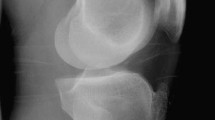Abstract
Objective: To review the MR appearances of Blount disease. Design and patients: The MR examinations of six knees in four patients (ages 6–7 years) with Blount disease were reviewed. Results: All patients showed delay in ossification of the medial tibial epiphysis. A spectrum of changes was seen in and around the tibial growth plate including: widening and depression of the medial growth plate; small and deep intrusions of cartilage into the metaphysis; edema of the medial tibial epiphysis and medial and lateral metaphysis; varus deformity of the lower leg; widening of the lateral growth plate; osteochondral injury to the medial femoral condyle; hypertrophy of the medial meniscus; focal bone bridging. Conclusion: MR appearances are consistent with the primary abnormality in Blount disease, which is failure of endochondral ossification of the medial growth plate. MR examination is useful in surgical planning.
Similar content being viewed by others
Author information
Authors and Affiliations
Additional information
Electronic Publication
Rights and permissions
About this article
Cite this article
Craig, J.G., van Holsbeeck, M. & Zaltz, I. The utility of MR in assessing Blount disease. Skeletal Radiol 31, 208–213 (2002). https://doi.org/10.1007/s00256-001-0464-x
Received:
Revised:
Accepted:
Published:
Issue Date:
DOI: https://doi.org/10.1007/s00256-001-0464-x




